Dick Best – the man who sank the Akagi and won the Battle of Midway
Between 1998 and 2001 when he died, I had the privilege of knowing one of the most interesting people I ever met, Dick Best, the man who sank the Akagi and changed the Battle of Midway. As you'll find out reading below, Dick did not think that was his greatest service to the country he was more than willing to die for.
From 2006:
Dick Best at the Battle of Midway:
The truly-decisive naval battles throughout history have been decisive on a far wider range than merely the battlefield, or even the war in which the battle took place. At Salamis, the Athenian galleys not only defeated the Persian invasion fleet of Xerxes, but determined that Western civilization would continue to exist and develop as a world force. Trafalgar didn't merely mean that Napoleon would not be able to invade England and would thereby end his career in defeat - it meant Great Britain would be the dominant world power for next 125 years. So, too, the Battle of Midway, fought June 4‑6, 1942, did not merely mean that the United States would eventually win the Pacific War, but more importantly, as a result of that battle the U.S. would be the dominant Pacific power in all the years since.
In every great battle, there comes a moment when it seems the Gods of War have chosen the winner, when one side - despite its best efforts - cannot do other than lose, while the other sweeps on to victory. At Midway, this moment came at approximately 10 a.m. on the morning of June 4, 1942, when the 32 Douglas SBD Dauntless dive bombers of Bombing‑6 and Scouting‑6 from the U.S.S. "Enterprise," led by Air Group Commander LCDR Clarence Wade McCluskey, arrived over the Japanese carrier force at its single most vulnerable moment.
At that point, the United States was losing. The air forces on Midway had launched small strikes at the Japanese that had been unsuccessful in damaging the fleet. Having sent their first strike against the island at dawn, the Japanese prepared the second strike which would knock out what was left of Midway's aircraft and ground defenses, and allow the soldiers of the accompanying invasion fleet to take possession of the strategic mid-Pacific atoll and give Japan effective control of the Western Pacific.
Just as Admiral Chuichi Nagumo, the Japanese commander, had given the order to launch the second strike at Midway, a garbled message came from a scout plane that reported at least one American carrier was operating northeast of the fleet. The message was met with incredulity on the part of the Admiral and his staff - all plans for the battle and invasion had been based on the presupposition that U.S. carriers would not arrive at Midway until after the island had been neutralized. For the Japanese, there should be no carrier where reported. But if it was true, the Battle of the Coral Sea had shown that the first strike would be decisive. Nagumo could not risk launching a second strike against Midway and allow the main enemy to make that critical first strike. He immediately decided that the Kido Butai would prepare to fight a fleet action.
This meant unloading the high‑explosive bombs and reloading with armor‑piercing bombs and torpedoes. In the midst of the reload, another strike by Midway-based aircraft appeared to demonstrate the need to neutralize the known enemy, while a second garbled message from the scout seemed to negate the first. Relieved, Nagumo ordered a second reload to strike Midway. Halfway through, a third message from the scout reported two American aircraft carriers.
When the order came for the third reload, the exhausted crews on the four carriers left bombs lying on the hangar decks next to fully‑fueled and armed aircraft as they hurried to rearm in the midst of an attack by American torpedo bombers from "Yorktown," "Enterprise" and "Hornet," in which the Japanese Combat Air Patrol shot down 32 of 36. The sacrifice of the torpedo bombers had drawn the CAP to wavetop level at just the worst moment. With the last of the American torpedo bombers shot down, Nagumo ordered his carriers to turn into the wind and commence launching the carrier attack strike.
As the first Zero accelerated down the deck of Nagumo's flagship, the lookouts screamed their warnings. High above, sunlight flashed on the canopies of American dive bombers as they commenced the single most important attack of the Pacific War. There was no time for the Japanese to do anything other than brace themselves.
Even with this tactical advantage, the "Enterprise" bombers almost blew the opportunity due to the fact that McCluskey - who previously commanded VF-6 before becoming Group Commander in May - was flying his first strike mission ever and was unfamiliar with dive bomber procedure, which called for McCluskey to take the lead squadron ‑ VS‑6 ‑ across the fleet to the far carrier of the two he had decided to attack, thus allowing the second squadron ‑ VB‑6 ‑ to make a simultaneous strike on the near carrier. McCluskey dove on the first carrier he saw, throwing off the coordination of the entire attack.
Leading Bombing‑6 was Lieutenant Richard H. "Dick" Best, Jr., Annapolis class of 1932 and a Naval Aviator since 1936. Best had transferred from flight leader with VF‑2, the elite "Flying Chiefs" squadron, to bombers in 1940, "because I knew we were going to war soon, and I wanted to make certain I was in a position to take the battle to the enemy." He had originally volunteered for torpedo bombers, seen then as the decisive strike squadrons of naval aviation, but did not have the seniority to keep a flight leader position in one of the in‑demand units; he took a transfer to dive bombers as the next-best choice.
As Best looked down at the Japanese fleet, he remembered the sight that had met his eyes the evening of December 7, 1941. "I thought about Pearl Harbor. We on Enterprise had been delayed a day due to bad weather, returning from taking a Marine fighter squadron to Wake Island. When I flew in to Ford Island that evening and saw the ships sunk, saw the airplanes destroyed, and learned of my friends who had been killed in the attack, I swore then I would do everything in my power to make them regret they had done that to us." The United States was about to be very lucky that Lieutenant Best had made the decision to take the assignment in dive bombers.
The first thing Best knew of McCluskey's incorrect attack was when the Air Group Commander's SBD dove directly in front of him. With the exception of Best's three‑plane lead section, the other aircraft of VB‑6 dove with McCluskey and VS‑6. In an instant, Best was left alone over the Japanese fleet with only two other dive bombers - according to U.S. Navy tactical doctrine, this force was not only insufficient, it was irrelevant. He led them to the far carrier and pushed over in what would be recorded as the single most accurate, devastating dive bomber attack by any pilot in the entire Second World War.
"I centered the sights on that big red rising sun painted on the deck. The flight deck was holystoned yellow and made an excellent target. I dropped my bomb at minimum altitude and as I pulled out I looked over my shoulder in time to see it hit just forward of the meatball." The other two members of the section, Lt(jg) Bill Kroeger and Ensign F. T. Weber, dropped their thousand‑pounders. Kroeger's hit amidships to the side and Weber's just off the stern, hits that were as damaging as torpedoes. Best's bomb penetrated the flight deck and exploded in the confined spaces of the hangar deck, where the armed and gassed strike aircraft waited to be brought to the deck for launch. The result was devastating. "By the time I leveled off," Best recounted, "the carrier was afire from bow to stern."
In the years since, there has been controversy as to which carrier was hit by whom, and who hit what. In the book "God's Samurai," Mitsuo Fuchida states the first bomb did not strike "Akagi," but was a near miss. To this, Best replied that anyone in Fuchida's position would duck before the hit, and that the three explosions would have come so close together as to be almost indistinguishable. Even at age 90, Best was an intense man, and was very intense on the point that he did indeed hit his target.
At almost the same time the Enterprise bombers found the Japanese, the Yorktown bombers under CDR Max Leslie independently discovered the fleet and dove on a third carrier at almost the same minute that the Enterprise strike dove on the first two. The four carriers of Nagumo's fleet were the Akagi, the Kaga, the Soryu and Hiryu. Just prior to the American attack, Hiryu had turned to launch aircraft and was not in the central formation; therefore the three strikes had to be against Akagi, Kaga and Soryu. Best had no doubt who did what: "McCluskey and the rest of our group hit Kaga. I sank the Akagi. I was very familiar with Japanese ship identification and the ship I hit had its island on the port side instead of the starboard side. The only carrier there with that configuration was Akagi. The Yorktown bombers sank Soryu."
According to Best, the Americans won the battle almost in spite of themselves. "We could have saved the torpedo bombers with a combined strike, but McCluskey blew it. Mac flew right over what we had plotted as the likely Japanese course, and then flew on to the limits of range before he made that right turn he should have made 25 minutes earlier." Best always believed the young pilots who were lost to fuel starvation during the return might have had a better chance of making it back had they not had to add nearly 40 minutes of tight formation flying to what was already a maximum‑range strike. "I knew we had blown it, because I had it plotted and I was an excellent navigator, but we were maintaining radio silence and there was no way to catch up with Mac and convince him to turn, without burning too much fuel to make it to the target."
What Best didn't know at the time was that during the flight from Enterprise, he'd had an accident that would profoundly change his life. As they climbed above 10,000 feet, the crews went on oxygen, using a rebreather system similar to that used by submarine crews of the period for emergency escapes. Several pilots and gunners suffered failures of the system, and began lagging behind as they dropped to lower altitude. Best remained at altitude, breathing with increasing difficulty, but not connecting his own problem to that experienced by the others. Once the attack was made, he flew back to the fleet at lower altitude, so the problem was not again apparent.
The first he knew that all was not right was when he got down to his stateroom aboard Enterprise and coughed up a large amount of blood. He reported to sick bay, where he was put to bed while the doctors checked him over. Before anything could be resolved, scouts found the Hiryu, and a strike was put together from the surviving crews from the Enterprise and now-homeless Yorktown squadrons. Every pilot who could fly was needed. Best checked out of sick bay and made the mission, again leading Kroeger and Weber.
The mission was not flown at high altitude, since by then it was known many of the oxygen sets were not operating correctly. Best was in the second flight to dive on the wildly‑evading carrier, and with this attack became one of very few men to ever dive on and participate in the sinking of two enemy aircraft carriers in one day. Unfortunately, Weber and his radioman were among those lost to Japanese flak. Kroeger survived and was able to make a reunion in May 1988 at the National Naval Aviation Museum in Pensacola, Florida, which was the first time he and Best had seen each other since the Enterprise docked in Pearl Harbor after the battle.
Best's landing back aboard Enterprise would be his last carrier trap, and the flight to strike Hiryu would be his last flight as a pilot, ever. "Many of my generation were exposed to tuberculosis as children, though it would remain dormant unless something happened to activate it. In my case, it was activated by the failure of the rebreather," he explained. Once back at Pearl Harbor, he was transferred to the U.S. Naval Hospital. The Navy promoted him to Lieutenant Commander and retired him from active service because of the disability, an action he fought hard to stop. "There were all kinds of men with worse problems than I had who remained on active duty during the war. I had participated in all the early war actions from Pearl Harbor to Midway with the exception of Coral Sea, and had experience the Navy could have used."
Several times after, Best would be close to death as a result of the disease, and was unable to find and keep steady employment because of this until shortly after the Korean War, when he was finally declared cured. For the next twenty years, he worked as the Chief Librarian for The Rand Corporation in Santa Monica. It was at the end of this period that he did something he was always far more proud of than he was of his efforts at Midway. “As librarian at Rand, I was the one who allowed Daniel Ellsberg and Anthony Russo to copy the ‘The Pentagon Papers,' as a result of which the American people learned of the lies and mendacity that had gone into creating and sustaining that war, and eventually took the steps to stop it."
Following retirement and the death of his wife in the 1980s, Best lived alone in a beautiful book‑filled Spanish‑Mission style home in Santa Monica, which is where I visited many times over the years of our friendship. Over the years he traveled across the country several weeks every month, speaking about Midway. In 1999, he said he had only two regrets: "My last cat died and I can't have another because I'm no longer in a position to promise him I would take care of him for the rest of his life, and I've lost enough of the upper and lower ranges of my hearing that I can't listen to music anymore."
Those of us fortunate to be friends of Dick Best were certain we'd gather in 2010 to celebrate his centenary. Unfortunately, he developed a persistent lung infection during the summer of 2001. That October, he went into the hospital complaining of chest pains. Four days later he slipped into a coma and died peacefully in his sleep on October 28, 2001, age 91. America lost a great hero and a true patriot that day.
The Dauntless won the decisive battles in the Pacific, which led directly to the destruction of fascism. It was truly "dauntless" in the darkest days of the Pacific War. Dick Best dedicated his life to his country and believed with all his heart in our highest ideals, and helped save us twice in our hour of need, at considerable risk to himself both times. In my book, the Dauntless is the greatest dive-bomber because of the ends it both served and created, and Dick Best was truly aptly named.
The model:
I opted to do Dick Best's SBD-3 as he flew it on June 4, 1942 at Midway. Dick told me that when VB-6 gave up their old SBD-2s after returning from the Doolittle mission at the end of April, 1942, they received brand-new SBD-3s that were as close to “factory new” as could be with having been shipped from California to Hawaii. As he described them, “they were the cleanest airplanes I ever saw in the Navy.”
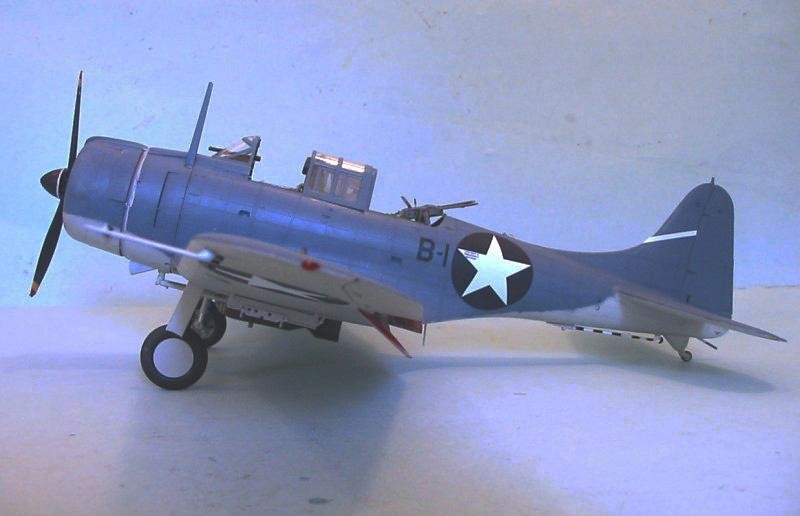
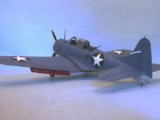
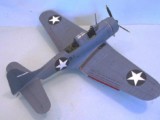
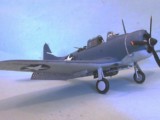
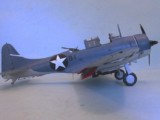
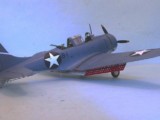
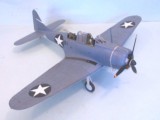
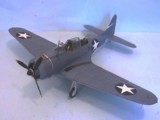
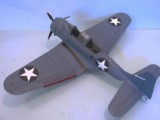
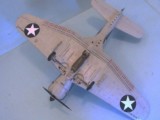
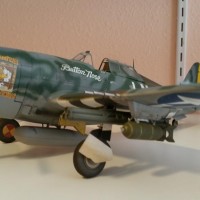
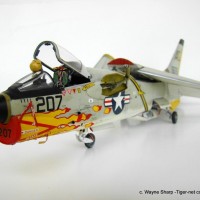
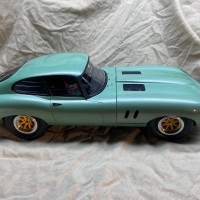
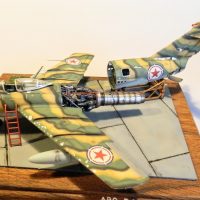
And a nice "clean" build it is...!
Fantastic story and well written. What model kit is it?
Trumpeter 1/32
Good history. I enjoyed the writing.
Nice build, and yes nice history lesson.
Great build and history
Tom
Great build...I really love the narrative, Tom. It brings the history alive. These guys were my heroes when I was a kid in the late 50's and a major reason I grew up to be a fighter pilot. VERY WELL DONE.
Beautiful build and story line. You were very fortunate to have known this man. He is truly an American Hero. Thanks for sharing his story with us Tom. Hand Salute .
Beautiful build and a great story.
A Courageous and Decent man!
And this is why I love to read your reviews, and the articles you write. Excellent addition to this Group Build, Tom, Bravo! And now I need to build my Trumpy SBD Looks like a great kit in the box.! Nice job Tom.
Basically, it's the A-M kit scaled up, some additional stuff around the engine.
A great tribute Tom. I wish I'd had the chance to meet Dick Best if only to thank him for his service.
This has to be read “at attention”. I understand criticism of the new Midway movie - perhaps a bit of cg excesses - but I couldn’t help enjoying it immensely. This is the stuff of heroes, the right stuff. As usual, a riveting narrative with a great build as the cherry on top.
I find this story wrong and insulting. My grandfather was there and flew both of those missions and got two confirmed hits. He was a Cherokee Indian SBD pilot from Texas. His name was James (Jay) Green. He crashed off of Guadalcanal where he had to fight with the marines for a while. During that time he was shot by a Japanese sniper and also caught malaria. He also went to sick bay after after the first Ship was sunk and was pulled out to fly the second mission. He has never been given proper recognition by anyone because he died young in the 1960s and most likely because he was an Indian. He accounted the story completely different to my father who is In ill health and I feel it is time to openly discuss it. As you may know there were not many Native American pilots and the ones that did fight were not given the same respect. I will be writing a letter to United States Navy for the first time ever regarding the issue in the coming weeks. I ask for the help of anyone that can. If you would like to contact me feel free to do so. I have every picture, medal, gear, the sniper rifle that shot him, Dog tag, letters, bayonet and patches. I even have every navy issued training book he ever received. Please help me if you can. My father is not in good health and I would like to have grandfathers accomplishments recognized before he passes away. Thanks.
4 attached images. Click to enlarge.